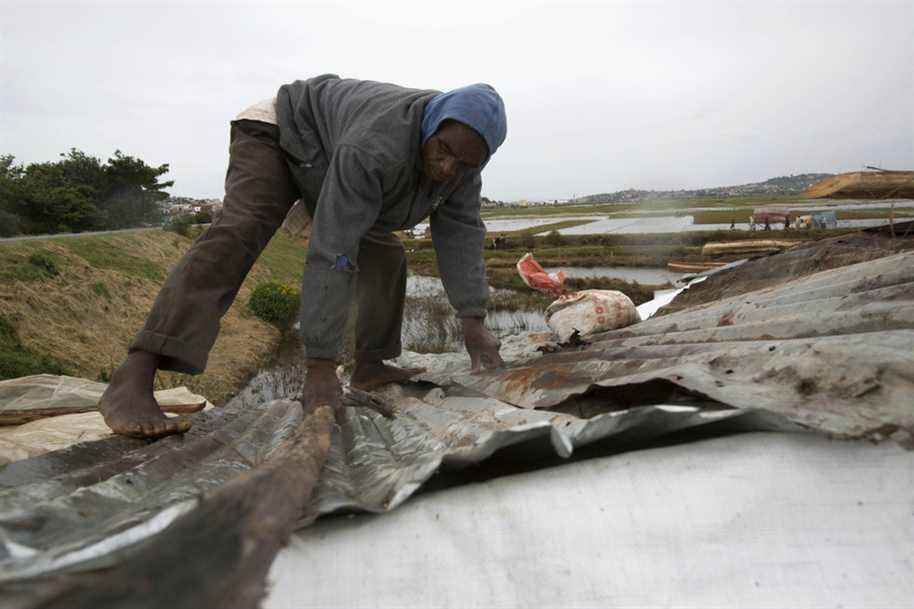(Vatomandry) The tropical cyclone Batsirai, which hit Madagascar on Saturday evening with gusts at 235 km / h, lost power overnight, but flooding is still to be feared due to heavy rains, indicates Sunday Météo-Madagascar.
Updated yesterday at 11:06 p.m.
“Batsirai has weakened. At 4 a.m. local time (1 a.m. GMT), its center is positioned in the Isandra district (center). The average wind is down to 80 km/h with local gusts of 110 km/h. It is moving towards the West at a rate of 19 km/h”, specify the Malagasy meteorological services.
According to Météo-Madagascar, “localized or generalized floods/floods remain to be feared following the heavy rains”, but Batsirai should “come out at sea in the Mozambique Channel at the level of the northern part of Atsimo Andrefana in the afternoon. or next night.
After pouring torrential rain for two days on the French island of Reunion, Batsirai made landfall around 8 p.m. (1700 GMT) on Saturday in the Mananjary district, more than 530 km southeast of the capital Antananarivo.
Batsirai made landfall “14 km north of the city of Mananjary, at the intense tropical cyclone stage”, with “a wind of 165 km / h and gusts at 235 km / h”, confirmed Faly Aritiana Fabien, a head of the National Office for Risk and Disaster Management.
Some 90 minutes after the arrival of the cyclone, the authorities had counted nearly 27,000 people who had left their homes, said Mr. Fabien, whose services prepared food, medicine and accommodation sites.
A little earlier, the weather service of Madagascar had warned that “significant and widespread damage” was to be feared.
The inhabitants have prepared with the means at their disposal on the island, one of the poorest countries in the world, already hit by a deadly tropical storm in January, Ana, and swept since Friday by the wind and continuous rain.
Ana, which also affected Malawi, Mozambique and Zimbabwe, left a hundred dead – including nearly sixty in Madagascar – and tens of thousands of victims.
In the coastal town of Vatomandry (east), hours before Batsirai’s arrival, more than 200 people had crowded into a room in a Chinese-owned concrete building for protection, with families sleeping on mats or mattresses.
A local official, Thierry Louison Leaby, complained about the lack of drinking water, the supply having been cut before the storm. “People are cooking with dirty water,” he said, fearing an outbreak of diarrhea. “The government must absolutely help us. We weren’t given anything.”
Outside, dishes and plastic cups collected rainwater pouring from corrugated iron roofs, often reinforced with heavy sandbags or jerry cans.
Some have put aside supplies. “We have been stocking up for a week, rice, but also cereals, because with the power cuts we can no longer keep meat or fish”, explained Odette Nirina, 65, hotelier in this seaside town. “I also stocked up on coal. We are used to cyclones here”.
The impact of Cyclone Batsirai in Madagascar is expected to be “considerable”, including in areas still recovering from Storm Ana, a spokesperson for the Office for the Coordination of Humanitarian Affairs (Ocha) warned on Friday. UN, Jens Laerke.
The director of the World Food Program (WFP) for Madagascar, Pasqualina Di Sirio, said she anticipated “a major crisis” on the Big Island, where the cyclone could affect more than 600,000 people, including 150,000 displaced. “We are very nervous,” she told reporters by videoconference.
Reinforced roofs
Search and rescue teams have been placed on alert, stocks of supplies have been prepared and planes are ready to intervene in support of the humanitarian response.
Around 4.4 million people in total are at risk in one way or another, according to the International Federation of Red Cross and Red Crescent Societies (IFRC), including “teams and partners” on place “are on alert and deployed in the communities”.
Every year during the hurricane season (from November to April), about ten storms or cyclones cross the south-west of the Indian Ocean, from east to west.
